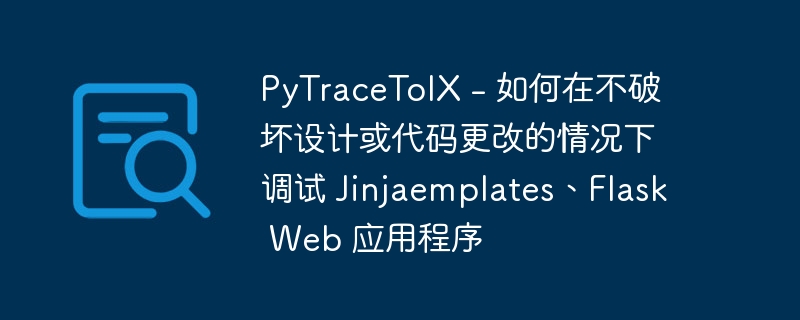◎欢迎参与讨论,请在这里发表您的看法、交流您的观点。
PyTraceToIX - 如何在不破坏设计或代码更改的情况下调试 Jinjaemplates、Flask Web 应用程序
ID:19451 / 打印
pytracetoix 是一个表达式跟踪器,设计用于调试 jinja2 模板、flask web 应用程序、lambda、列表推导式、方法链和一般表达式。
代码编辑器通常无法在此类表达式中设置断点,这需要大量代码修改才能有效调试。
对于 jinja2 模板,可以使用调试扩展,但它通常会转储整个上下文,从而很难隔离特定问题。 pytracetoix 通过允许开发人员跟踪特定数据并将其直接写入 sys.stdout 或流来解决此问题,而无需更改设计或对 web 应用程序进行任何更改。
此外,pytracetoix 可以捕获多个输入及其结果,将它们全部显示在一行中,从而更轻松地查看聚合数据和跟踪值流。
pytracetoix 为这些挑战提供了一个简单的解决方案,简化了调试,同时保留了原始代码库的完整性。
它的设计很简单,具有易于识别的功能,一旦发现错误就可以将其删除。
pytracetoix 有 2 个主要功能:
- c__ 捕获表达式输入的输入。例如:c__(x)
- d__ 显示表达式的结果和所有捕获的输入。例如: d__(c__(x) + c__(y))
还有 2 个可选功能:
- init__ 初始化显示格式、输出流和多线程。
- t__ 定义当前线程的名称。
安装
pip install pytracetoix
jinja2 模板用法
在此示例中:
- flask web 应用程序使用 jinja2 模板
- 它生成一个购物卡 html 表,其中包含产品、数量和最终价格
| product | qty | final price |
|---|---|---|
| smartphone | 5 | 2500 |
| wireless b | 50 | 49960 |
| smartphone | 20 | 1990 |
- 产品名称只有前11个字符,但我们需要知道全名。
- 仅显示最终价格,即价格*数量-折扣。
- 折扣取决于数量。
- c__ 捕获完整名称,但不更改设计。
- c__ 捕获数量并将其标记为数量。
- c__ 捕获折扣值。
- d__ 将所有捕获的输入和最终价格输出到 sys.stdout。
标准输出将显示这些行:
i0:`smartphone 128gb` | qty:`5` | i2:`500` | discount:`0` | _:`2500` i0:`wireless bluetooth headphones` | qty:`50` | i2:`1000` | discount:`40` | _:`49960` i0:`smartphone 64gb black` | qty:`20` | i2:`100` | discount:`10` | _:`1990`
jinja2 模板:
<html lang="en"> <head><link href="https://cdn.jsdelivr.net/npm/bootstrap@5.3.0-alpha3/dist/css/bootstrap.min.css" rel="stylesheet"></head> <body> <div class="container mt-5"> <h1>shopping cart</h1> <table class="table table-striped"> <tr><th>product</th><th>qty</th><th>final price</th></tr> {% for item in purchases %} {% set product = products[item['product']] %} <tr> <td>{{ c__(product['name'])[0:10] }}</td> <td>{{ c__(item['qty'], name='qty') }}</td> <td>{{ d__(c__(product['price']) * item['qty'] - c__(discount(item['qty']), name='discount')) }}</td> </tr> {% endfor %} </table> </div> </body> </html> app.py:
from flask import flask, render_template from pytracetoix import c__, d__ app = flask(__name__) app.jinja2_env.globals['d__'] = d__ app.jinja2_env.globals['c__'] = c__ discounts = {50: 40, 20: 10, 10: 5, 0: 0} products = { 'wb50cc': {'name': 'wireless bluetooth headphones', 'price': 1000}, 'ph20xx': {'name': 'smartphone 128gb', 'price': 500}, 'ph50yy': {'name': 'smartphone 64gb black', 'price': 100} } purchases = [ {'product': 'ph20xx', 'qty': 5}, {'product': 'wb50cc', 'qty': 50}, {'product': 'ph50yy', 'qty': 20} ] def discount(qty): return next((k, v) for k, v in discounts.items() if k <= qty)[1] @app.route('/', methods=['get']) def index(): return render_template('index.html', products=products, purchases=purchases, discount=discount) if __name__ == '__main__': app.run(debug=true) 如前面的示例,我们将 c__ 添加到 app.py 上的折扣函数中:
def discount(qty): return c__(next((k, v) for k, v in discounts.items() if k <= qty))[1]
它将在输出中添加更丰富的折扣信息:
i0:`Smartphone 128GB` | qty:`5` | i2:`500` | i3:`(0, 0)` | discount:`0` | _:`2500` i0:`Wireless Bluetooth Headphones` | qty:`50` | i2:`1000` | i3:`(50, 40)` | discount:`40` | _:`49960` i0:`Smartphone 64GB Black` | qty:`20` | i2:`100` | i3:`(20, 10)` | discount:`10` | _:`1990`
